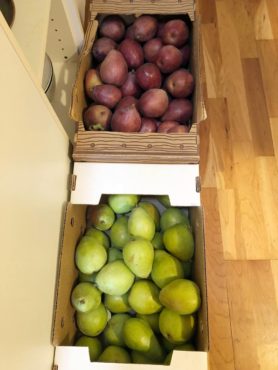 Passing through Ellensburg in pear season, one is compelled to stop at a fruit stand and be enraptured by the presence of firm, ripe, voluptuous pears. Pears can be red, green and yellow in color, and they grow in sizes from prune-sized seckels to anjous as big as a fist.
Passing through Ellensburg in pear season, one is compelled to stop at a fruit stand and be enraptured by the presence of firm, ripe, voluptuous pears. Pears can be red, green and yellow in color, and they grow in sizes from prune-sized seckels to anjous as big as a fist.
Pears do not ripen on the tree, but are harvested while still hard, and ripen while shipping or on the kitchen countertop. Commercial growers store them for months in oxygen-free environments, allowing for ripening in grocery stores and in consumers’ kitchens after purchase.
When purchasing large quantities (I bought about 40 pounds), ripening can be controlled by storage conditions. Keeping pears in a cool, dark place will slow ripening, while keeping them in a bright, warm spot will hasten the ripening process.
Various types of processing methods demand different stages of fruit ripening and it is important for the home cook to understand the differences for optimum preservation results.
As a fruit’s flavor is enhanced during ripening, and the starch converts to sugar, the fruit begins to soften and break down. Preservation methods that require long cooking periods, such as chutneys, produce more successful results if firmer fruits are used. The texture of poached pears after canning or freezing is better if ripe but firm pears are used.
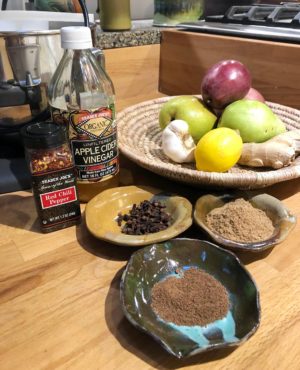 The poaching and preservation processes each take their toll on the consistency of the finished product. Pears that are simply peeled, lightly simmered in a preserving syrup and canned in jars in a water bath should be just about the ripeness for eating raw — slightly soft and juicy, but not at all mushy.
The poaching and preservation processes each take their toll on the consistency of the finished product. Pears that are simply peeled, lightly simmered in a preserving syrup and canned in jars in a water bath should be just about the ripeness for eating raw — slightly soft and juicy, but not at all mushy.
Fruit should be inspected for level of ripeness. All seeds and stems as well as any dark spots must be removed. Peel the fruit if the recipe calls for it. Canned pears are always peeled, but some peels can be left in place for chutneys, which have more texture.
Glacé and Chutneys
While waiting for a large quantity of fresh fruit to reach the appropriate stage of ripeness for the desired preservation method, the impatient home processor can start with recipes using the firmest fruits, and progress to those requiring a greater degree of ripeness as time goes on.
A couple ways to use ripe but still hard fruit are by making glacé fruits and chutneys. Glacé fruits are a time-honored tradition in Europe and early America, being served as special treats and garnishes on Thanksgiving and Christmas tables. Glacé fruits are sold in England and Europe at holiday markets from glistening trays of jewel-toned, mouth-watering lusciousness.
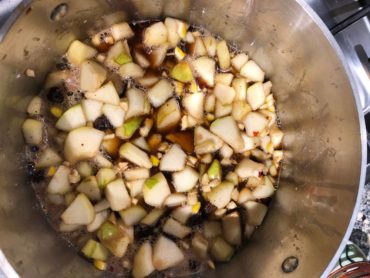 A little time-consuming but not difficult, glacé pears are a satisfying way to use up a few excess pieces of fruit.
A little time-consuming but not difficult, glacé pears are a satisfying way to use up a few excess pieces of fruit.
Chutneys are appreciated the world over as accompaniments to spicy or rich foods. Made from melons, squash or fruits such as mango, apples and pears, they complement curried dishes in India and “Ploughman” lunches of bread and cheese in England, and balance the richness of beef, pork, lamb, poultry and wild game.
Probably our beloved cranberry sauce started out as a tart fruit chutney, but eventually the spices and vinegar were eliminated and only the sugar was retained in the sauce. The cranberry-orange relish that is popular on many Thanksgiving tables is a form of chutney.
Below is a recipe for a sweet and savory pear chutney. It pairs particularly well with cheese and crackers, with poultry, and it cuts the richness of grilled sausages.
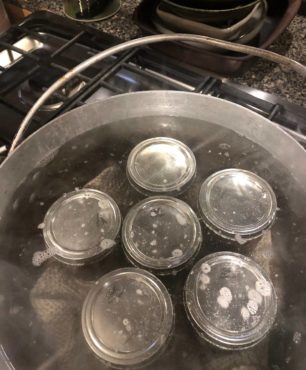 Other Preservation Methods
Other Preservation Methods
Of course, the most common way to preserve pears is simply by a quick simmer in a sugar syrup and canning in glass jars. Preserved in this manner, the fruit can be used in a variety of ways for months to come. Removing the hot jars from the canner and listening for the “ping” indicating the lid has sealed gives one sense of satisfaction that the job is nearly complete.
The final step in preserving food by any method is to wipe off the jars or containers and label them with the contents and date. Home-canned pears should be eaten within eight to 12 months, frozen pears within four months, and preserved chutneys within two years.
There are many resources available for learning the details of food preservation. A very informative book that contains reliable information can be downloaded from the U.S. Department of Agriculture National Institute of Food and Agriculture website. This guide includes full instruction on selecting jars and equipment for home canning.
Nearly everything that is suitable for canning may also be frozen. Information on freezing fresh fruit is also available online. The Montana State University Extension has an excellent guide.
Cleanliness is first and foremost the most important criteria for any type of home food preservation. Before beginning, all utensils, pans, jars and plastic containers should be thoroughly washed in hot and soapy water, rinsed and dried.
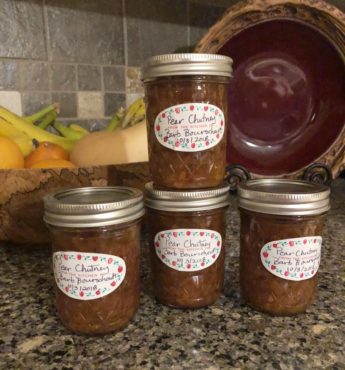 Spicy Pear Chutney
Spicy Pear Chutney
Ingredients:
- 10 medium pears (about 3 pounds)
- 12 ounces unfiltered apple cider vinegar
- 1 1/2 cup raisins
- 1 medium lemon, seeded.
- 2 cloves garlic
- 1 2-inch knob ginger, peeled
- 1/4 tsp red chili flakes
- 1/2 tsp salt
- 1/4 tsp each: allspice, black pepper, ground coriander
- Pinch of ground cloves
Instructions:
Cut pears in half lengthwise; remove stems and cores. Remove about half of the peel. Chop pears into 1/4- to 1/3-inch pieces. Finely chop lemons, ginger and garlic.
Place all ingredients in large pot. Mix thoroughly and cook over medium heat until all ingredients are soft. Continue to cook until moisture thickens and divides when a spoon is drawn through the middle of the pot.
Remove from heat, spoon into clean 8-ounce jars, cover with sterilized lids, and place them in a water bath for 20 minutes.





























Comments